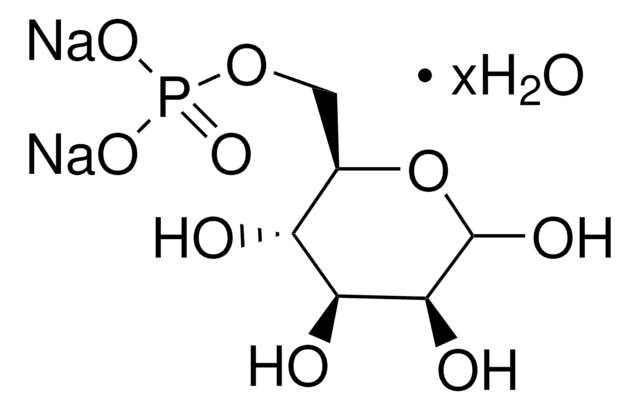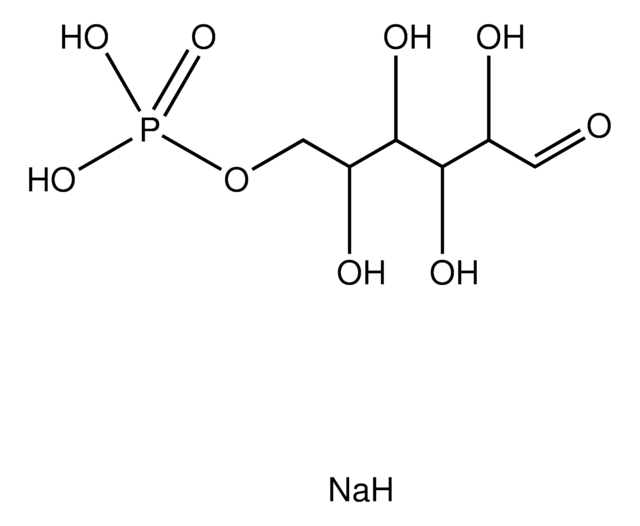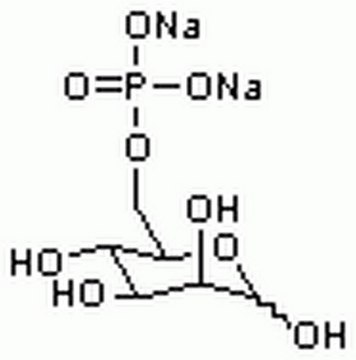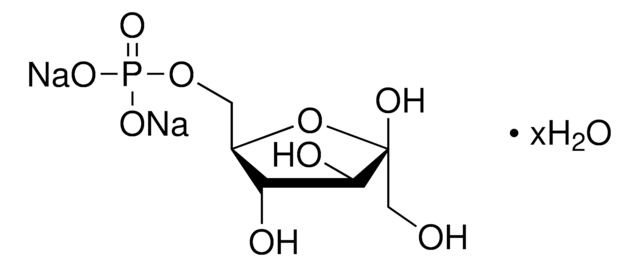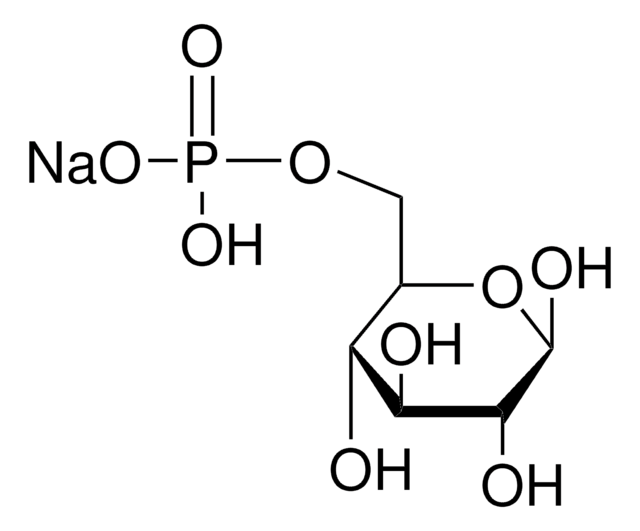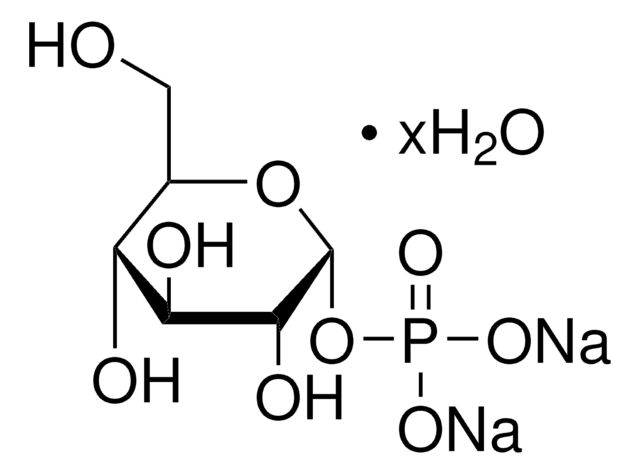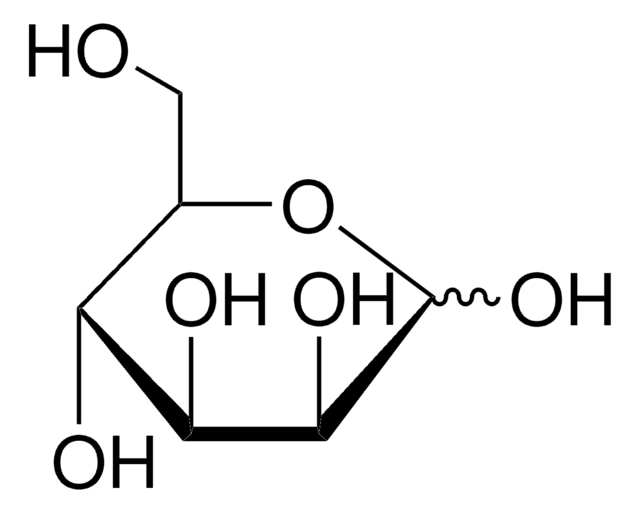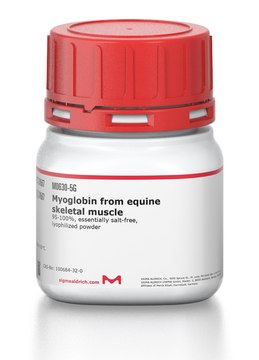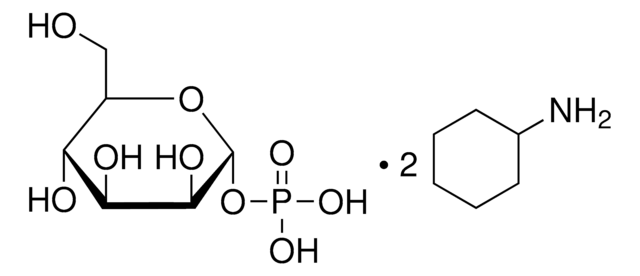M1755
α-D(+)Mannose 1-phosphate sodium salt hydrate
≥98% (TLC), Sigma Grade
Synonym(s):
α-D-Mannopyranosyl phosphate
Sign Into View Organizational & Contract Pricing
All Photos(2)
About This Item
Empirical Formula (Hill Notation):
C6H13O9P · xNa+ · yH2O
Molecular Weight:
260.14 (anhydrous free acid basis)
UNSPSC Code:
12352201
NACRES:
NA.25
Recommended Products
biological source
plant (Phytolacca fructus / pokeweed)
Quality Level
grade
Sigma Grade
Assay
≥98% (TLC)
form
powder
optical activity
[α]25/D 36 to 45 °, c = 1% (w/v) in water
technique(s)
thin layer chromatography (TLC): suitable
color
white
solubility
water: 50 mg/mL, clear, colorless
cation traces
Na: 14.0-16.0% (anhydrous)
storage temp.
−20°C
General description
Mannose is a monosaccharide.
Application
Mannose has been used in a study to assess effects of dietary probiotic inclusion levels on intestinal mucin composition. It has also been used in a study to investigate the carbohydrate specificity of pradimicin-S.
Biochem/physiol Actions
D-Mannose 1-phosphate is an intermediate in fructose and mannose metabolism.
Other Notes
To gain a comprehensive understanding of our extensive range of Monosaccharides for your research, we encourage you to visit our Carbohydrates Category page.
Storage Class Code
11 - Combustible Solids
WGK
WGK 3
Flash Point(F)
Not applicable
Flash Point(C)
Not applicable
Personal Protective Equipment
dust mask type N95 (US), Eyeshields, Gloves
Regulatory Information
监管及禁止进口产品
Choose from one of the most recent versions:
Already Own This Product?
Find documentation for the products that you have recently purchased in the Document Library.
Supatra Karnjanapratum et al.
International journal of biological macromolecules, 51(5), 720-729 (2012-07-17)
Sulfated polysaccharides isolated from Capsosiphon fulvescens and fractionated using ion-exchange chromatography were investigated to determine their chemical and molecular characteristics and biological activities. The crude and fractionated polysaccharides (F(1), F(2), and F(3)) consisted mostly of carbohydrates (28.9-67.0%), uronic acids (1.6-9.2%)
Syed Shahzad-ul-Hussan et al.
Journal of the American Chemical Society, 134(30), 12346-12349 (2012-07-14)
The pradimicin family of antibiotics is attracting attention due to its anti-infective properties and as a model for understanding the requirements for carbohydrate recognition by small molecules. Members of the pradimicin family are unique among natural products in their ability
P Tsirtsikos et al.
Poultry science, 91(8), 1860-1868 (2012-07-18)
The aim of this study was to investigate the effect of dietary probiotic inclusion level on mucin composition (monosaccharide ratio), mucosal morphometry, mucus layer staining intensity, and mucus layer thickness along the broiler intestinal tract. One-day-old male Cobb broilers were
José A Caparrós-Martín et al.
Planta, 237(4), 943-954 (2012-11-28)
This work presents the isolation and the biochemical characterization of the Arabidopsis thaliana gene AtSgpp. This gene shows homology with the Arabidopsis low molecular weight phosphatases AtGpp1 and AtGpp2 and the yeast counterpart GPP1 and GPP2, which have a high
Jessica P Lao et al.
G3 (Bethesda, Md.), 9(2), 413-423 (2018-12-12)
Phosphomannomutase 2 Deficiency (PMM2-CDG) is the most common monogenic congenital disorder of glycosylation (CDG) affecting at least 800 patients globally. PMM2 orthologs are present in model organisms, including the budding yeast Saccharomyces cerevisiae gene SEC53 Here we describe conserved genotype-phenotype
Our team of scientists has experience in all areas of research including Life Science, Material Science, Chemical Synthesis, Chromatography, Analytical and many others.
Contact Technical Service